Orange butterflies are a common sight in various environments, from woodlands to fields, and their vibrant colors make them a delight to observe. However, identifying different species of orange butterflies can be challenging due to their similar appearances.
- The Types Of Sharks From Finding Nemo
- The Top 3 Fastest Snakes In The United States Have Unbelievable Speed
- Discover 4 Animals That Lurk Atop Hawaii’s Tallest Mountain
- Discover The Top 5 Largest And Most Dangerous Snakes In Louisiana This Summer
- Discover The Top 8 Most Expensive Types Of Cows In The World
In this article, we will explore 10 types of orange butterflies, complete with pictures and identification details, to help you better understand and appreciate these beautiful creatures.
You are reading: 10 Types Of Orange Butterflies With Pictures And Identification Guide
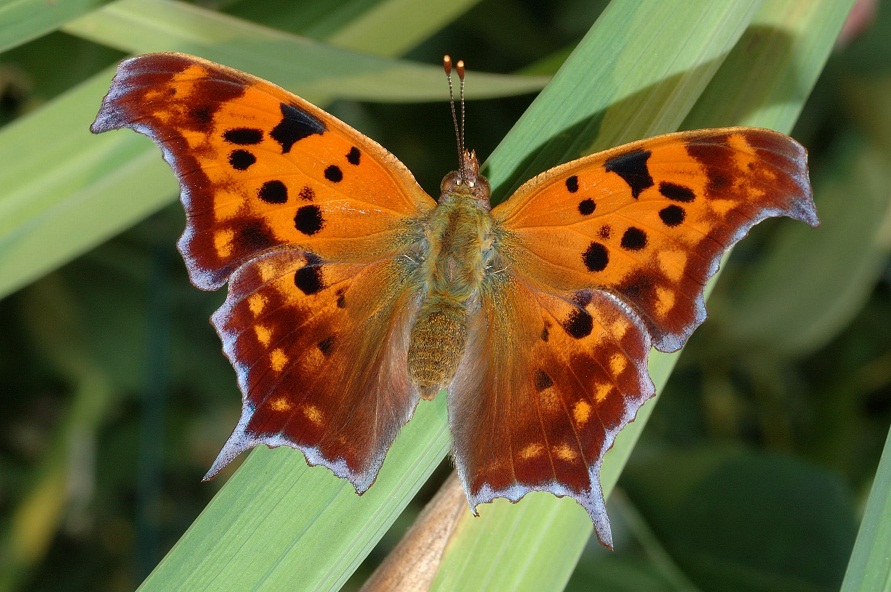
10 Types Of Orange Butterflies With Pictures And Identification Guide
Monarch Butterfly (Danaus plexippus)
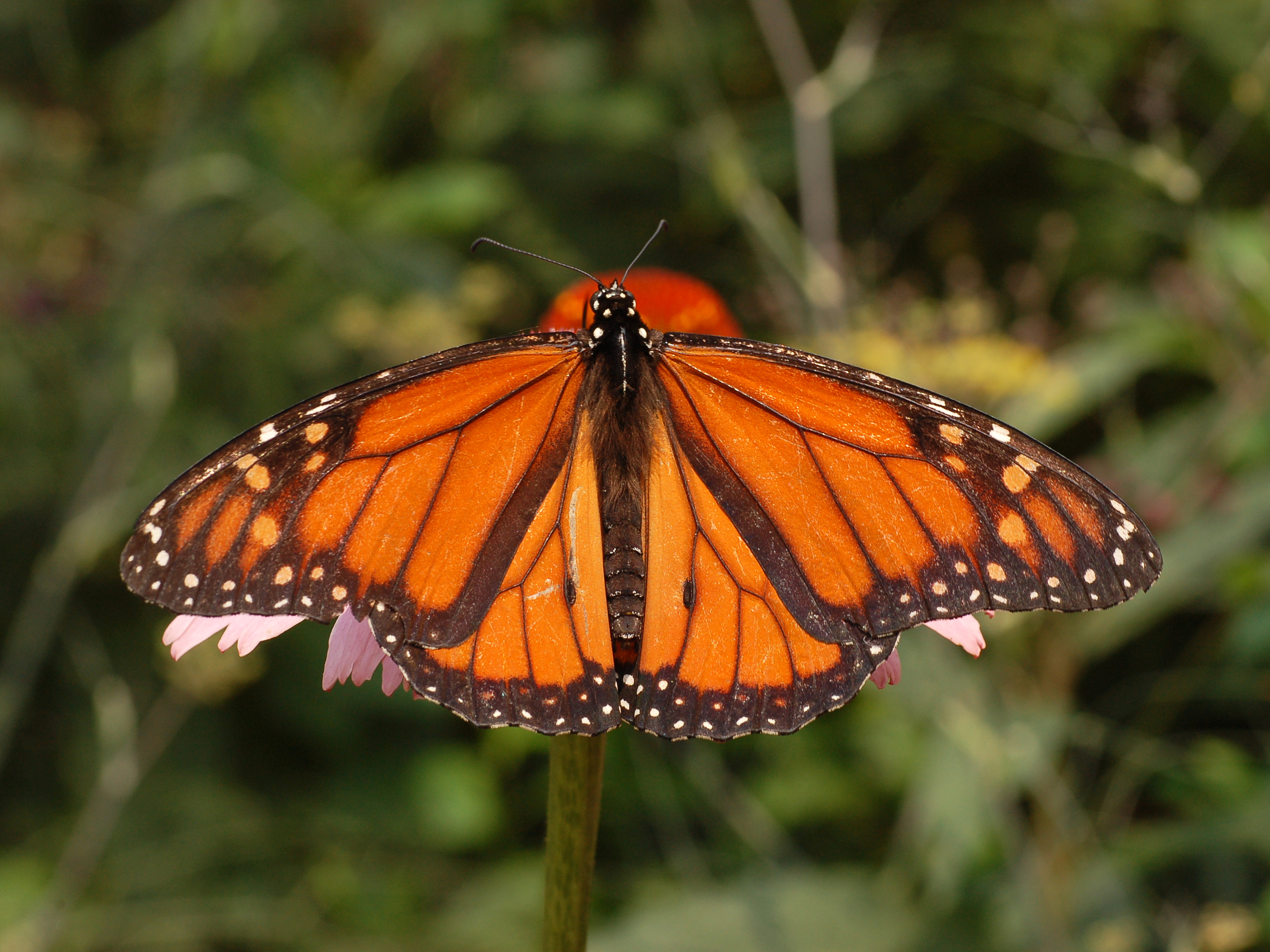
The Monarch Butterfly (Danaus plexippus) is a large and conspicuous insect with bright orange wings surrounded by a black border and covered with black veins . Its distinct appearance makes it easy to identify, especially with the top portion of its wings being orange with black veins.
Here are some key characteristics and facts about the Monarch Butterfly:
– Scientific Name : Danaus plexippus
– Common Name : Monarch Butterfly
– Family : Nymphalidae
– Group Name : Flutter
– Diet : Herbivore, feeding on milkweed plants
– Average Life Span : Six to eight months
– Size : Large, with a wingspan of 3.7 to 4.1 inches (9.4 to 10.4 cm)
The Monarch Butterfly has a unique relationship with milkweed plants, as they are the only food source for its caterpillar stage.
These plants contain toxins that make the caterpillars and adult butterflies poisonous to predators. An animal that eats a Monarch Butterfly usually doesn’t die but feels sick enough to avoid them in the future.
One of the most remarkable aspects of Monarch Butterflies is their enormous migration. Every fall, as cold weather approaches, millions of North American Monarchs undertake a journey of over 1,000 miles to reach their wintering grounds in Mexico and California. This instinctive migration is a fascinating phenomenon that continues to captivate researchers and nature enthusiasts alike.
Fiery Skipper (Hylephila phyleus)
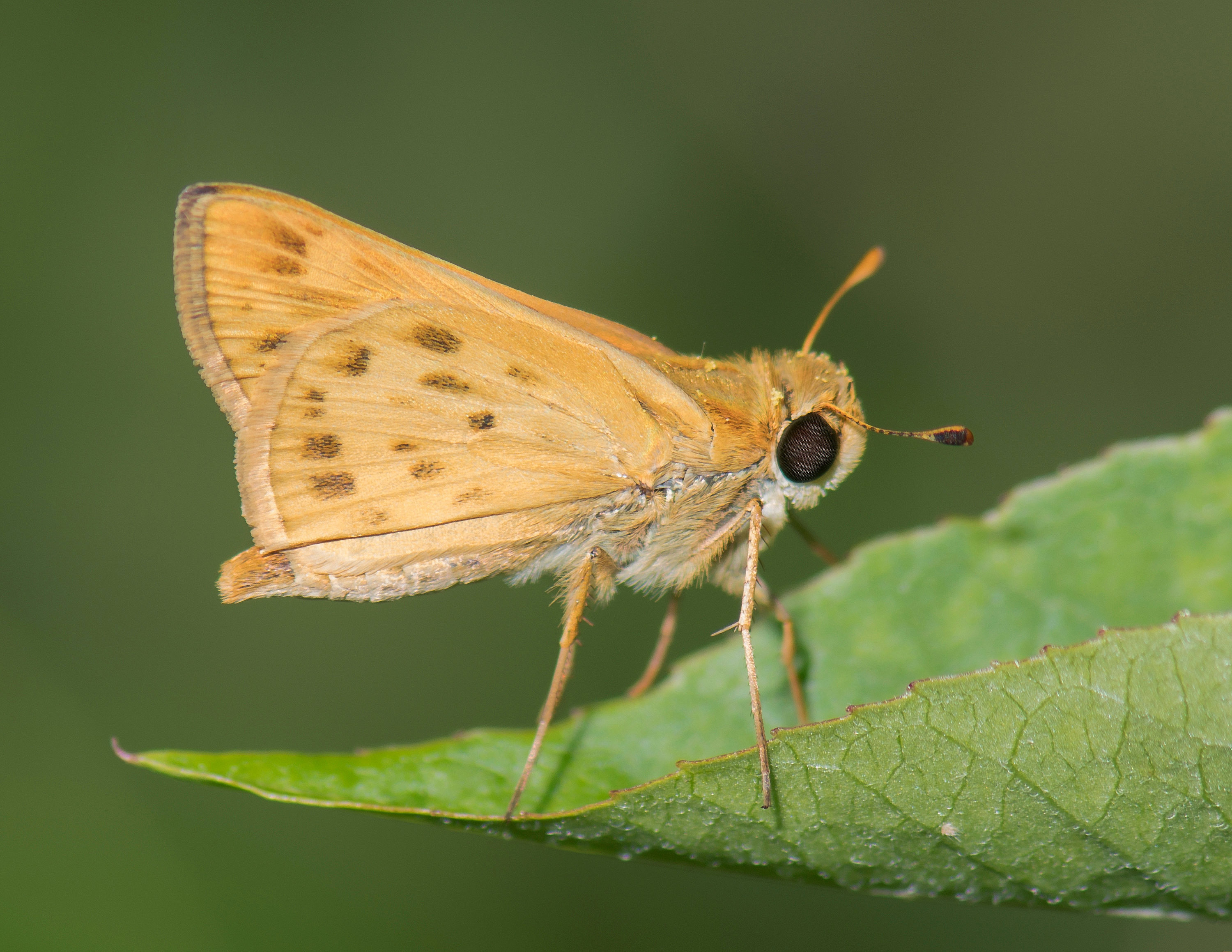
The Fiery Skipper (Hylephila phyleus) is a species of butterfly in the family Hesperiidae, commonly found in various habitats across North America.
Here are some key characteristics and facts about the Fiery Skipper:
– Scientific Name : Hylephila phyleus
– Common Name : Fiery Skipper
– Family : Hesperiidae
– Size : Approximately 1 inch (2.5 cm) in length, with a wingspan of 1-1¼ inches (2.6-3.2 cm)
– Sexual Dimorphism : Male fiery skippers are orange or yellow, while females are dark brown
– Wing Spots : Small brown spots may be observed on both the hindwing and forewing of both sexes, although to a varying degree
The Fiery Skipper is known for its short antennae and a hooked knob at the end, which is a characteristic feature of the Hesperiidae family. This butterfly is often found in grassy areas, where it blends in with its surroundings .
The reproductive habits of Fiery Skippers have been extensively studied, with experiments conducted at the University of California Davis in 1974 to understand their life cycle and mating behavior .
While the Fiery Skipper is not considered a significant pest, it can occasionally be found in turfgrass areas, where its larvae feed on grass blades . Understanding the life cycle and habits of this species can help in managing its presence in such environments.
Painted Lady (Vanessa cardui)
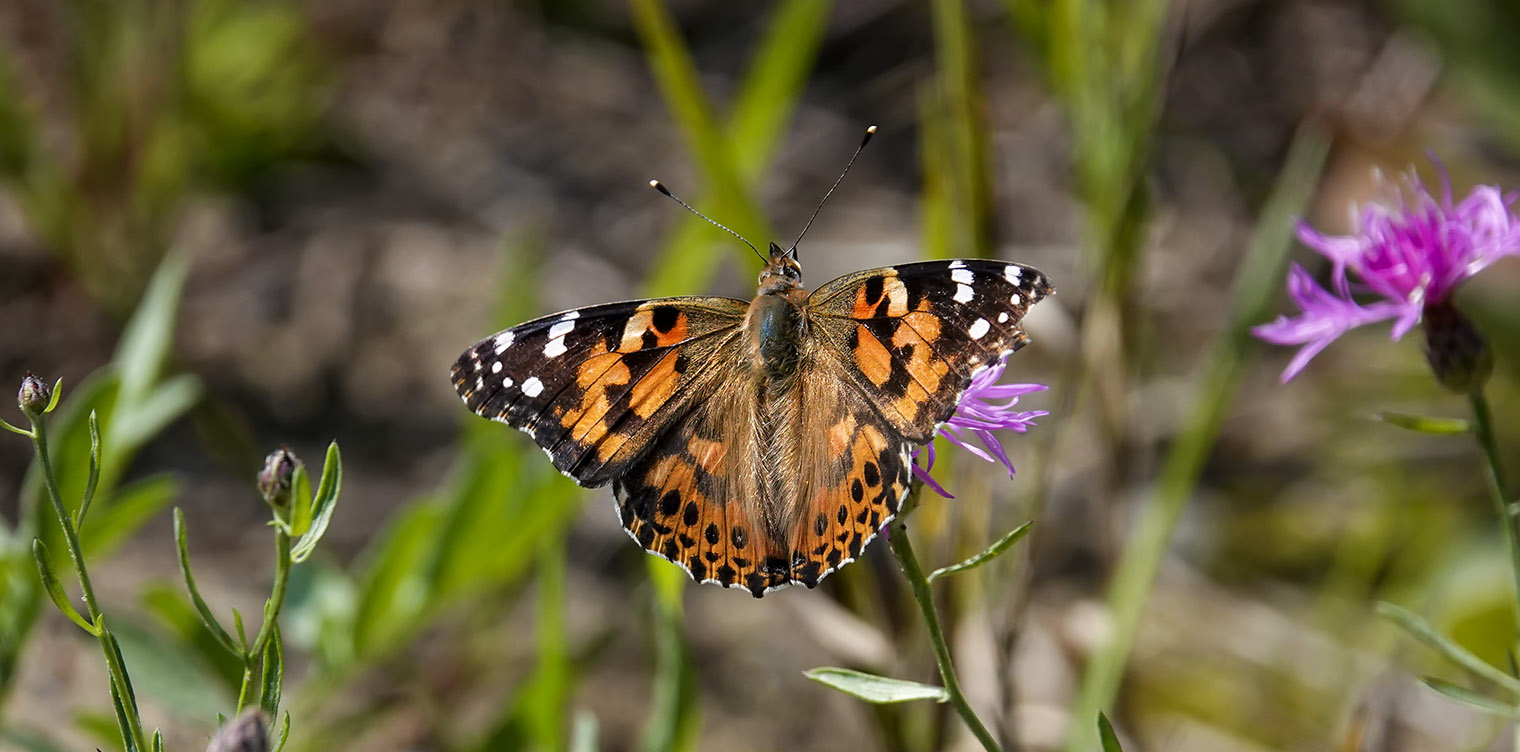
The Painted Lady (Vanessa cardui) is the most widespread butterfly species in the world, found in Europe, Asia, Africa, North America, and Central America. Here are some key characteristics and facts about the Painted Lady:
– Scientific Name : Vanessa cardui
– Common Name : Painted Lady
– Family : Nymphalidae
– Size : Approximately 2-2½ inches (5-6.4 cm) in wingspan
– Sexual Dimorphism : Females are generally larger than males
– Habitat : Various habitats, including gardens, meadows, and deserts
The upper side of the Painted Lady’s wings is pinkish-orange with thick black lines and white spots near the tips of the forewings. Its underside is a mottled gray, brown, and black with four small spots near the margins.
This butterfly is also known as the thistle butterfly because it is often found on thistle plants, although it also feeds on other plants .
The Painted Lady is known for its remarkable migratory behavior. In most years, it moves north from the deserts of northern Mexico and the southwestern United States to temporarily colonize the United States and Canada, south of the Arctic. These migrations can result in the species being locally abundant at times .
Understanding the habits and characteristics of the Painted Lady can help us appreciate its role as one of the most familiar and widely distributed butterflies in the world.
Gulf Fritillary Butterfly (Agraulis vanillae)

The Gulf Fritillary Butterfly (Agraulis vanillae) is a bright orange butterfly belonging to the subfamily Heliconiinae of the family Nymphalidae. Here are some key characteristics and facts about the Gulf Fritillary:
– Scientific Name : Agraulis vanillae
– Common Name : Gulf Fritillary Butterfly
– Family : Nymphalidae
– Subfamily : Heliconiinae
– Size : Medium-sized butterfly with extended forewings and a wingspan range of 6.5 to 9.5 cm
– Sexual Dimorphism : Females are typically larger in size than males
– Habitat : Common across extreme southern portions of the United States
The Gulf Fritillary Butterfly exhibits distinct coloration and patterns on its wings. The underside of the wings is brown and speckled with silvery white dots, while the top surface layer is deep orange with black streaks running across . This butterfly is categorized as a “longwing” due to its elongated wings.
In terms of its life cycle, the Gulf Fritillary is entirely dependent on introduced species of the tropical genus Passiflora (Passion Flower) as its host plant. Understanding the relationship between this butterfly and its host plants can help in conserving its populations and supporting its role in local ecosystems.
Variegated Fritillary Butterfly (Euptoieta claudia)
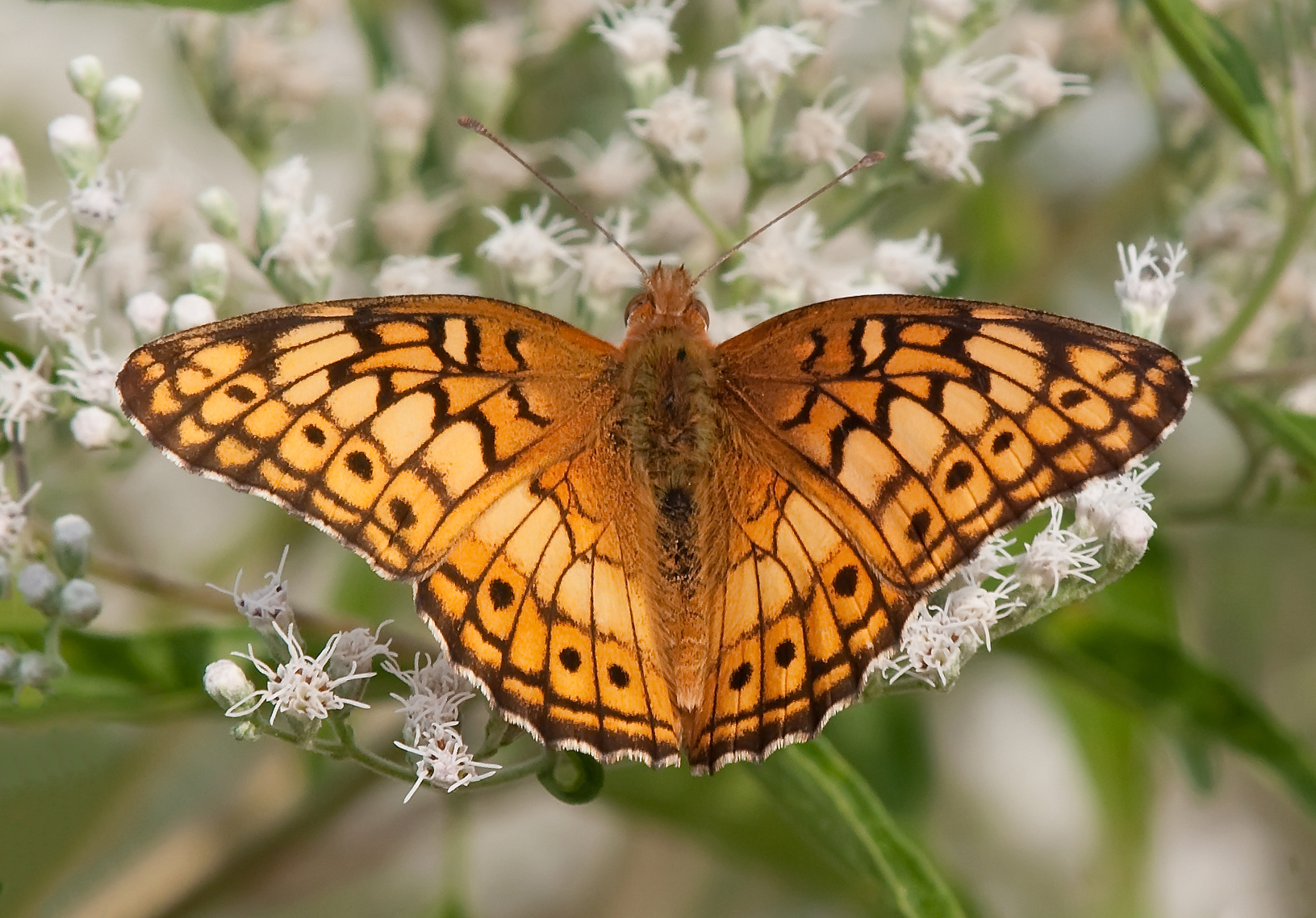
The Variegated Fritillary Butterfly (Euptoieta claudia) is a North and South American butterfly belonging to the family Nymphalidae. Here are some key characteristics and facts about the Variegated Fritillary:
– Scientific Name : Euptoieta claudia
– Common Name : Variegated Fritillary
– Family : Nymphalidae
– Size : Wingspan ranging from 1¾ to 3¼ inches (4.5 to 8 cm)
– Habitat : Found in a variety of habitats, including open fields, meadows, gardens, and roadsides
– Flight Period : In the south, it may be seen flying from April to October, while in the north, it flies from summer to early fall
The Variegated Fritillary has a distinct appearance with a brownish-orange upper side, featuring a complex checkered pattern of black markings and dark dots. Its underside is a mottled brown with a row of submarginal spots and median black lines .
This butterfly is closely related to the Speyeria fritillaries, although it exhibits some different characteristics, such as having two or three broods per year, being nomadic, and using a wide range of host plants.
In its range, the only similar species is the Mexican fritillary (Euptoieta hegesia), which can be distinguished by its brighter orange color, unmarked upper side of the hindwing basal area, and plainer underside.
Understanding the habits and characteristics of the Variegated Fritillary can help in appreciating its role in local ecosystems and supporting its conservation.
Additionally, its larvae, known as pansyworms, are small, orange to red, spiny caterpillars that feed on various host plants, including lance-leaf stonecrop (Sedum lanceolatum) and American field pansy (Viola bicolor) .
Viceroy Butterfly (Limenitis archippus)
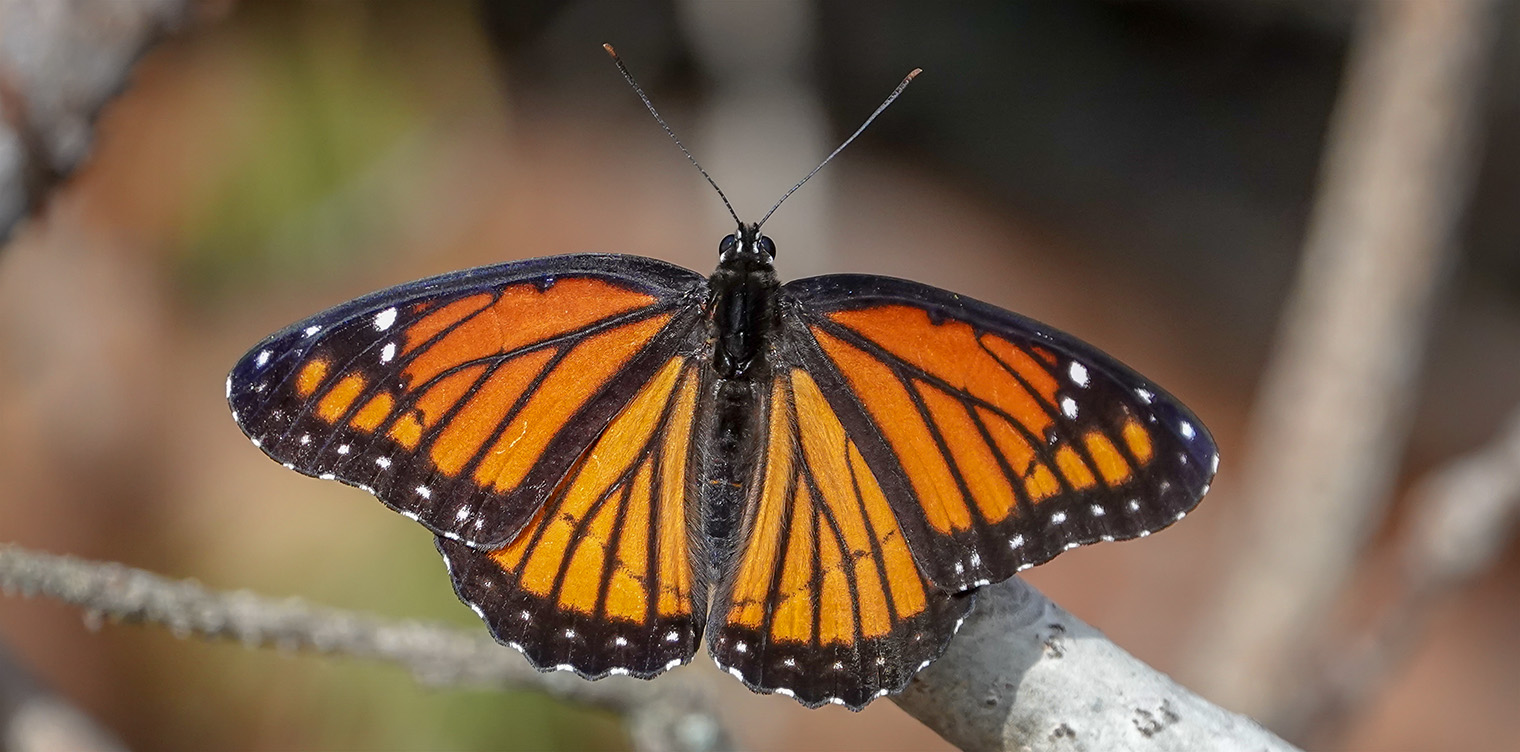
The Viceroy Butterfly (Limenitis archippus) is a North American butterfly known for its striking orange and black coloration . Here are some key characteristics and facts about the Viceroy:
– Scientific Name : Limenitis archippus
– Common Name : Viceroy Butterfly
– Family : Nymphalidae
– Size : Medium-sized butterfly with a wingspan ranging from 2.75 to 3.25 inches (7 to 8.3 cm)
– Habitat : Meadows, marshes, swamps, and other wet areas with willow, aspen, and poplar trees
– Diet : The caterpillar feeds on the leaves of willow and poplar trees, while the adult butterfly feeds on dung, carrion, fungi, and the nectar of flowers from the Asteraceae family, such as goldenrod, thistles, and asters
The Viceroy Butterfly was once thought to exhibit Batesian mimicry, where a harmless species mimics a toxic species, specifically the Monarch Butterfly (Danaus plexippus).
However, studies conducted in the early 1990s suggest that the Viceroy and the Monarch are actually examples of Müllerian mimicry, where two equally toxic species mimic each other .
Understanding the habits and characteristics of the Viceroy Butterfly can help in appreciating its role in local ecosystems and supporting its conservation.
Additionally, its caterpillars make shelters from rolled leaf tips in which to spend the winter .
Orange Sulphur Butterfly (Colias eurytheme)
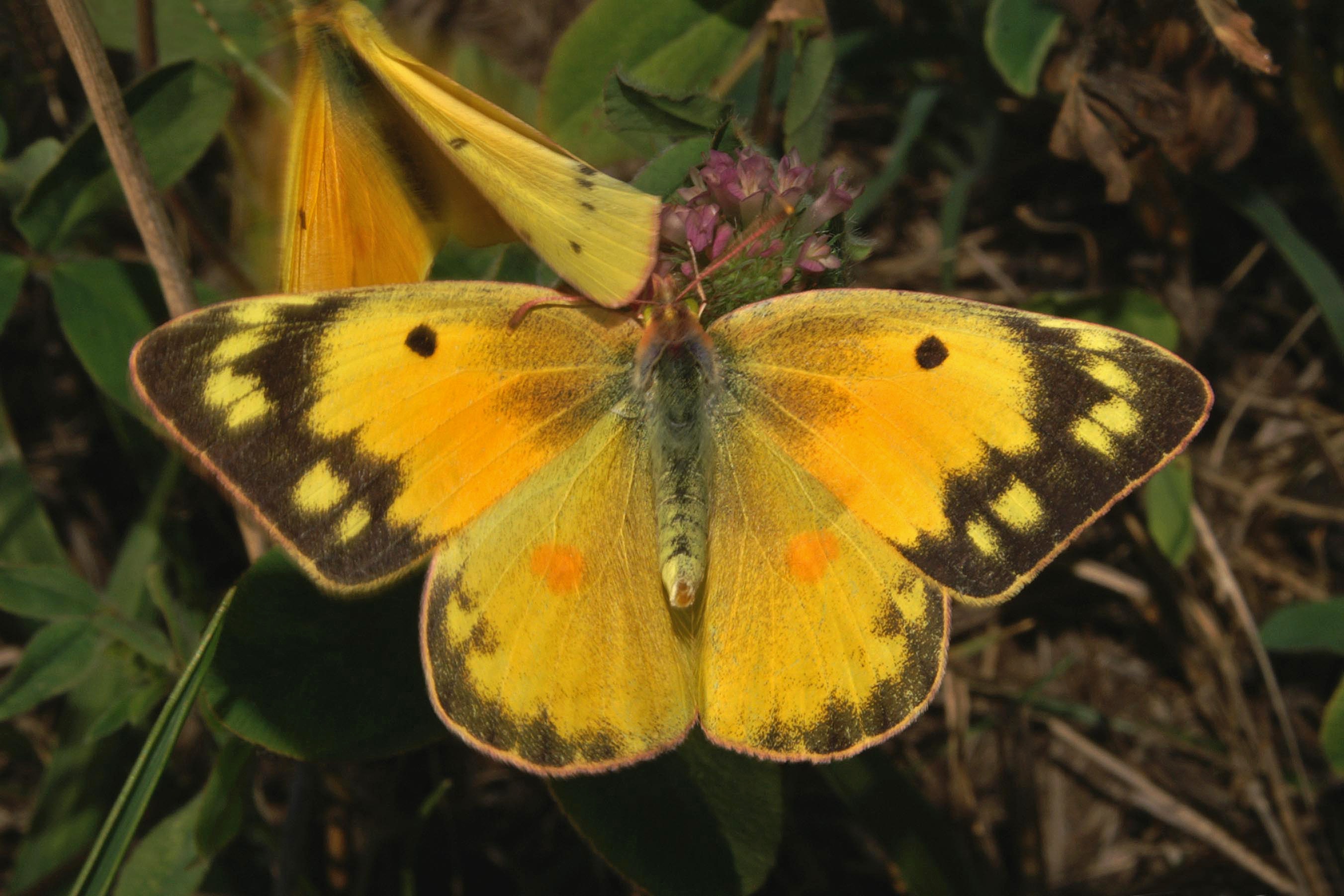
The Orange Sulphur Butterfly (Colias eurytheme), also known as the Alfalfa Butterfly, is a medium-sized butterfly found throughout North America, from southern Canada to Mexico. Here are some key characteristics and facts about the Orange Sulphur:
– Scientific Name : Colias eurytheme
– Common Name : Orange Sulphur Butterfly, Alfalfa Butterfly
– Family : Pieridae
– Size : Medium-sized butterfly with a wingspan of about 2 inches (5 cm)
– Habitat : Open areas, meadows, fields, and gardens, often near its preferred host plant, alfalfa
– Diet : The caterpillar feeds on the leaves of various legumes, including alfalfa, clover, and vetch, while the adult butterfly feeds on nectar from a variety of flowers
The Orange Sulphur Butterfly is quite variable in appearance, but its wings are typically yellowish and orange, with dark brown to black edging on the upper surface.
The males have solid black borders on their wings, while the females have pale spots within their black borders. This butterfly is often seen with its wings closed, which can make identification more challenging .
Read more : Discover 10 Animals That Prowl Atop Massachusetts’s Tallest Mountain
The Orange Sulphur undergoes complete metamorphosis, with adults breeding in the spring through late summer and producing up to four broods. Males patrol for females, using the characteristic female ultraviolet light reflectance pattern on the dorsal wing surface for identification.
Understanding the habits and characteristics of the Orange Sulphur Butterfly can help in appreciating its role in local ecosystems and supporting its conservation.
Julia Butterfly (Dryas iulia)

The Julia Butterfly (Dryas iulia), also known as the Julia Heliconian, the Flame, or the Flambeau, is a species of brush-footed butterfly and the sole representative of its genus Dryas. Here are some key characteristics and facts about the Julia Butterfly:
– Scientific Name : Dryas iulia
– Common Names : Julia Butterfly, Julia Heliconian, Flame, Flambeau
– Family : Nymphalidae (Brush-Footed Butterflies)
– Size : Medium-sized butterfly with elongated forewings
– Habitat : Tropical and subtropical areas of North, Central, and South America, including Brazil, Ecuador, Bolivia, and various Caribbean islands
– Diet : The Julia Butterfly feeds on the nectar of various flowers, and its caterpillars feed on specific host plants, although the exact species may vary
The Julia Butterfly is known for its vibrant orange coloration and elongated wings. It is a diurnal species, meaning it is active during the day, and can often be found in butterfly houses due to its attractive appearance and behavior.
This butterfly is also admired for its mimicry, specifically Batesian mimicry, where it resembles toxic species to deter predators .
In the United States, the Julia Butterfly is primarily found in the southernmost parts of Florida and Texas. Its host plants may include various species, depending on the region and availability.
Understanding the habits and characteristics of the Julia Butterfly can help in appreciating its role in local ecosystems and supporting its conservation .
American Lady (Vanessa virginiensis)
The American Lady (Vanessa virginiensis) is a butterfly species found throughout North America, from southern Canada to northern South America. Here are some key characteristics and facts about the American Lady:
– Scientific Name : Vanessa virginiensis
– Common Names : American Lady, American Painted Lady
– Family : Nymphalidae (Brush-Footed Butterflies)
– Size : The wingspan of the American Lady ranges from 1.75 to 2.75 inches (4.45 to 6.6 cm)
– Habitat : Open areas, meadows, fields, gardens, and roadsides
– Diet : The caterpillars of the American Lady feed on various Asteraceae plants, such as cudweeds, pussytoes, and everlastings, which all belong to the tribe Gnaphalieae
The American Lady is known for its distinctive orange and black coloration, with white spots located on the tips of the forewings. The upperside of its wings has an uneven pattern of brown, yellow, and orange.
This butterfly is often seen resting on flowers, such as the purple coneflower and butterfly bush, while feeding on nectar .
The American Lady is a migratory species, and its presence has been observed in Europe, Hawaii, and the Caribbean, in addition to its native range.
Understanding the habits and characteristics of the American Lady can help in appreciating its role in local ecosystems and supporting its conservation.
Question Mark Butterfly (Polygonia interrogationis)
The Question Mark Butterfly (Polygonia interrogationis) is a North American nymphalid butterfly commonly found in wooded areas, city parks, and other locations with a combination of trees and open space. Here are some key characteristics and facts about the Question Mark Butterfly:
– Scientific Name : Polygonia interrogationis
– Common Name : Question Mark Butterfly
– Family : Nymphalidae (Brush-Footed Butterflies)
– Size : The wingspan of the Question Mark Butterfly ranges from 4.5 to 7.6 cm (1.8 to 3.0 in)
– Habitat : Wooded areas, city parks, and areas with a combination of trees and open space
– Diet : The caterpillars of the Question Mark Butterfly feed on various species of hackberry trees (Celtis spp.), while the adults feed on rotting fruit, tree sap, and sometimes flower nectar
The Question Mark Butterfly gets its name from a distinctive silver or white “question mark” shape on the underside of its hindwings.
The color and textured appearance of the underside of its wings provide camouflage that resembles a dead leaf, helping it blend in with its surroundings. The upper side of its wings is bright orange towards the top and deep black at the bottom.
The flight period of the Question Mark Butterfly is from May to September. Understanding the habits and characteristics of the Question Mark Butterfly can help in appreciating its role in local ecosystems and supporting its conservation.
FAQS
1. What are some common predators of orange butterflies?
Orange butterflies, like other butterfly species, have various predators in their ecosystems. Some common predators include wasps, birds, spiders, and praying mantises. However, it’s important to maintain a balanced ecosystem and not eliminate these predators, as they play crucial roles in the natural food chain.
2. How can I attract orange butterflies to my garden?
To attract orange butterflies to your garden, you can provide them with suitable nectar sources and host plants. Planting flowers such as milkweed, zinnias, marigolds, and lantanas can help attract these beautiful insects. Additionally, providing a water source, such as a shallow dish with pebbles, can be beneficial for butterflies.
3. Are orange butterflies harmful to humans or plants?
Orange butterflies are not harmful to humans or plants. In fact, they are important pollinators and play a crucial role in maintaining the balance of ecosystems. Some species, like the Monarch Butterfly, even have a mutualistic relationship with certain plants, such as milkweed, which they rely on for food and reproduction.
4. How can I help conserve orange butterfly populations?
There are several ways you can contribute to the conservation of orange butterfly populations. Planting native host plants and nectar sources in your garden, avoiding the use of pesticides, and supporting local conservation efforts are all effective ways to help protect these beautiful insects and their habitats.
5. Can I raise orange butterflies at home?
Yes, you can raise orange butterflies at home by providing them with suitable host plants and a safe environment. However, it’s important to research the specific needs of the butterfly species you are interested in raising and to release them back into the wild once they have completed their life cycle.
Source: https://petstutorial.com
Category: Animals










